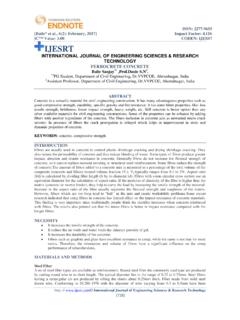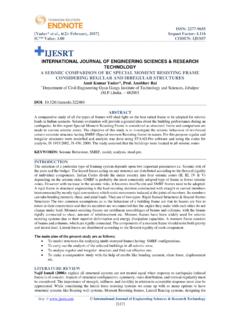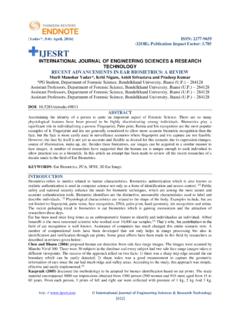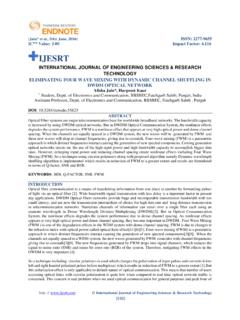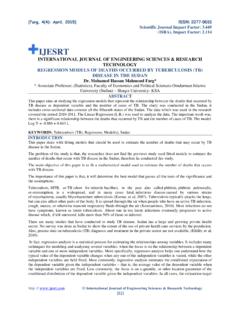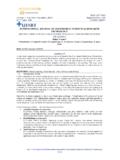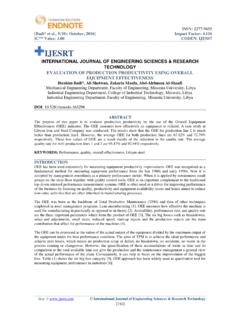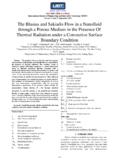Transcription of IJESRT
1 [Rauta&Mishra, 4(4):April, 2015] ISSN: 2277-9655 Scientific Journal Impact Factor: (ISRA), Impact Factor: http: // International Journal of Engineering Sciences & Research Technology [302] IJESRT INTERNATIONAL JOURNAL OF ENGINEERING SCIENCES & RESEARCH TECHNOLOGY BOUNDARY LAYER FLOW AND HEAT TRANSEFER OF DUSTY FLUID OVER A STRETCHING SHEET WITH HEAT SOURCE/SINK &. Lecturer, Department of Mathematics, , Paralakhemundi, Odisha, India Adjunct Professor, Department of Mathematics, CUT M, Paralakhemundi, Odisha, India _____ ABSTRACTIn this paper, we contemplate to study the unsteady dusty fluid problem over a continuous Impermeable stretching sheet in the presence of heat source / sink.
2 The highly non-linear, coupled partial differential equations governing the momentum and heat transfer equations are reduced to a system of coupled non-linear ordinary differential equations by applying suitable similarity transformation. These non-linear coupled ordinary differential equations are solved numerically by Runge-Kutta method along with shooting technique for different values of the parameters. These includes the effect of unsteady parameter, heat source/sink parameter, Froud number, Grashof number, Prandtl number, Eckert number, Volume fraction, fluid interaction parameter etc. The velocity and temperature distributions are discussed numerically and presented through graphs. Skin-friction coefficient and the Nusselt number at the sheet are derived, discussed numerically and their numerical values for various values of physical parameters are presented through tables.
3 A numbers of qualitatively distinct potential scenarios are predicted. It is believed that the results obtained from the present investigation will provide useful information for application and also serve as a complement to the previous investigations. AMS classification 76T10, 76T15 KEYWORDS: Heat source/sink parameter ,Unsteady parameter, Volume fraction, Fluid particle interaction parameter,Boundarylayerflow,Stretchingsh eet. _____INTRODUCTION In reality, most of the fluids such as molten plastics, polymers, suspension, foods, slurries, paints, glues, printing inks used in the industrial applications are non-Newtonian in nature, especially in polymer processing and chemical engineering processes etc. That is, they might exhibit dramatic deviation from Newtonian behavior depending on the flow configuration and/or the rate of deformation.
4 These fluids often obey nonlinear constitutive equations, and the complexity of their constitutive. The momentum and Heat transfer in the laminar boundary layer flow on a moving surface is important for both practical as well as theoretical point of view because of their wide applications such as ; in heat removal from nuclear fuel debris, the aerodynamic extrusion of plastic sheet, glass blowing, cooling or drying of papers, drawing plastic films, extrusion of polymer melt-spinning process and rolling and manufacturing of plastic films and artificial fibers, waste water treatment, combustion, paint spraying etc. During the manufacture of these sheets, the melt issues from a slit and is subsequently stretched to achieve the desired thickness. The mechanical properties of the final product strictly depend on the stretching and cooling rates in the process.
5 The study of boundary layer flow and heat transfer over a stretching sheet has generated much interest in recent years in view of above numerous industrial applications .The study of the boundary layer flow over a stretched surface moving with a constant velocity was initiated by Sakiadis [4] in 1961. However, according to Wang [23], Sakiadis solution was not an exact solution of the Navier-Stokes (NS) equations. Then many researchers extended the above study with the effect of heat transfer by considering various aspects of this problem and obtained similarity solutions. A similarity solution is one in which the number of independent variables is reduced by at least one, usually by a coordinate transformation. Grubka [9] investigated the temperature field in the flow over a stretching surface when subject to uniform heat flux.
6 Chen [8] investigated mixed convection of a power law fluid past a stretching surface in presence of thermal radiation and magnetic field .Crane [13] has obtained the Exponential solution for planar viscous flow of [Rauta&Mishra, 4(4):April, 2015] ISSN: 2277-9655 Scientific Journal Impact Factor: (ISRA), Impact Factor: http: // International Journal of Engineering Sciences & Research Technology [303] linear stretching sheet. Gireesha [7] have studied the effect of hydrodynamic laminar boundary layer flow and heat Transfer of a dusty fluid over an unsteady stretching surface in presence of non uniform heat source/sink.
7 They have examined the Heat Transfer characteristics for two type of boundary conditions namely variable wall temperature and variable Heat flux. Gireesha [6] also studied the mixed convective flow a dusty fluid over a stretching sheet in presence of thermal radiation, space dependent heat source/sink. [19] have investigated the MHD flow with heat source .Swami Mukhopdhya [20] has studied the Maxwell fluid with heat source and sink. The problem of two phase suspension flow is solved in the frame work of a model of a two-way coupling model or a two-fluid approach. [14] et al. has studied MHD Stagnation-Point Flow towards a Heated Stretching Sheet. Anoop Kumar [3] have studied the Impact of Soret and Sherwood Number on stretching sheet using Homotopy Analysis Method. Tie gang [21] have studied Viscous Flow with Second-Order Slip Velocity over a stretching sheet.
8 Singh [17] have analyzed MHD flow with viscous dissipation and chemical reaction over a stretching porous plate in porous medium. Noura S. Al-sudais [16] has investigated the thermal radiation effects on MHD fluid flow near stagnation point of linear stretching sheet with variable thermal conductivity. N. Bachok [15] et studied the flow and heat transfer over an unsteady stretching sheet in a micro polar fluid with prescribed surface heat flux. K. V. Prasad [12] have investigated the momentum and heat transfer of a non-Newtonian eyring-powell fluid over a non-isothermal stretching sheet. [1] have investigated the heat transfer on MHD viscous flow over a stretching sheet with prescribed heat flux. Hitesh Kumar [11] has studied the heat transfer over a stretching porous sheet subjected to power law heat flux in presence of heat of the above mentioned studies dealt with stretching sheet where the unsteady flows of dusty fluid due to a stretching sheet have received less attention; a few of them have considered the two phase flow.
9 Motivated by the above investigations, in this paper the study of effect of different flow parameters of unsteady boundary layer and heat transfer of a dusty fluid over a stretching sheet have investigated. Here, the particles will be allowed to diffuse through the carrier fluid the random motion of the particles shall be taken into account because of the small size of the particles. This can be done by applying the kinetic theory of gases and hence the motion of the particles across the streamline due to the concentration and pressure diffusion. We have considered the terms related to the heat added to the system to slip-energy flux in the energy equation of particle phase, The momentum equation for particulate phase in normal direction, heat due to conduction and viscous dissipation in the energy equation of the particle phase have been considered for better understanding of the boundary layer characteristics.
10 The effects of volume fraction on skin friction, heat transfer and other boundary layer characteristics also have been studied. Further we consider the temperature dependent heat source/sink in the flow. The governing partial differential equations are reduced into system of ordinary differential equations and solved by Shooting Technique using Runge-Kutta Method. To the best of our knowledge this problem has not been considered before, so that the reported results are new. 2. Mathematical formulation and solution: Thermal x boundar layer g u v T Momentum boundary layer
